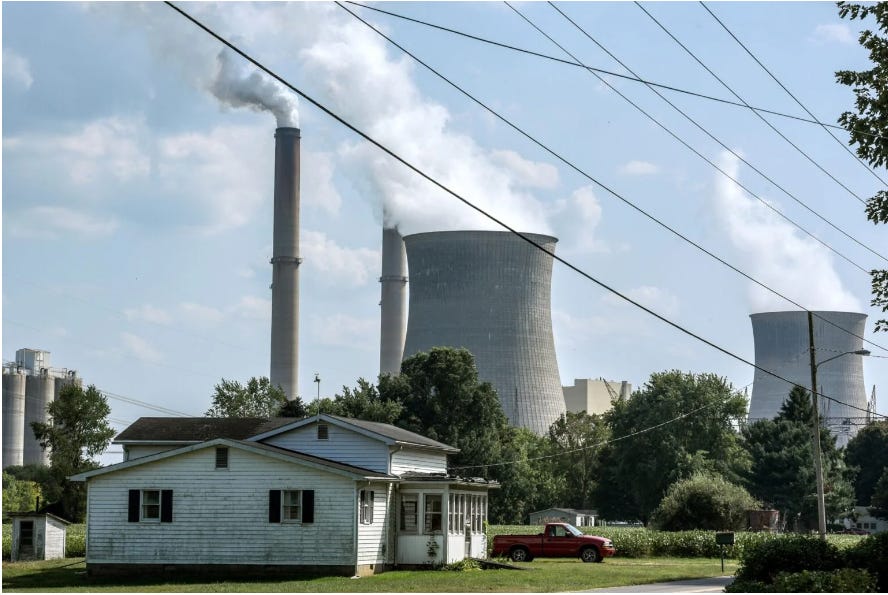EPA Cleans Up Its (Coal) Act…Or Have They?
BY NICK ROGERS
CHESHIRE, OHIO - Recent enforcement of a 2015 EPA “Final Rule” on the disposal and sequestration of Coal Combustion Residuals (CCR) at Cheshire, Ohio’s Gavin Power plant was met with two energy industry lawsuits accusing the EPA of misinterpreting its own mandate. A third, contextually paradoxical lawsuit looms; one in which an environmental advocacy organization accuses the EPA of failing to enforce the very rules and regulations which spawned the aforementioned ire of the energy industry.

The crux of the energy industry lawsuits – one of which was filed by Gavin Power, LLC, the owner of Cheshire, Ohio’s Gavin Power Plant – revolves semantically around the definition of the term “free liquid” as it relates to ground water’s interaction with CCR and the possible role that plays in chemicals leaching out of the impoundment site.
Industry council Stephen Gidiere argued, “Once it becomes groundwater, it’s not a free liquid any more.” Gavin Kearney, deputy managing attorney for EARTHJUSTICE’s clean energy program, disagreed, saying, “Maybe if groundwater never moves you could have an unlined impoundment and still be okay. But at Gavin, this water is flowing through the waste. That’s generally what water does. It doesn’t just sit in the ground. It moves.”
An April 2021 deadline was set by the EPA for all unlined impoundment sites to no longer receive coal ash. The sites were mandated to “close” in a way that prevented water infiltration and, subsequently, water/CCR interaction. Those that did not meet this requirement were to be impermeably lined, and all CCR was to be separated, removed, and placed into a lined landfill.
Gavin requested an extension to the 2021 deadline; a request which was denied. The extension request prompted further EPA investigation into Gavin’s adherence to existing CCR regulations, and numerous violations were found including a reservoir that was closed with CCR waste sitting in groundwater.
The 2015 EPA ruling – issued as an amendment to the Resource Conservation and Recovery Act (RCRA) of 1976 – established a “comprehensive set of requirements” for disposal of CCR in landfills and surface impoundments. It laid out a list of disposal site monitoring techniques that are to be periodically carried out, including but not limited to “…structural stability assessments” (to be performed by a qualified engineer), “…hazard potential classification assessments,” and “…weekly inspections of the CCR unit and monthly monitoring of unit instrumentation.” The ruling also describes “run-on and run-off” criteria for containment units to help prevent waste water from entering surface water.
The ruling included the creation of publicly available databases for impoundment site-specific rule adherence information access. These databases exist, but they are lengthy, confusing, and often published by the very companies potentially at fault for water contamination due to CCR-related leachate.
The EPA – ostensibly the “good guy” in this case, has a less than stellar reputation when it comes to transparency and enforcement of its own water contamination rules and cleanup procedures. A 2022 report released by EARTHJUSTICE asserts that nine out of ten CCR impoundments nationwide are in violation of the EPA’s rules, but that the EPA has not held them accountable. As a result, the group claims, immense amounts of water near these sites – often drinking water sources – is being contaminated with chemicals such as arsenic and mercury . According to the report, approximately 75% of impoundment sites are within a quarter mile of a body of water.
As a result of this research and information compilation, the EPA has found itself in more hot legal water; this time in the form of a lawsuit by EARTHJUSTICE accusing the regulatory agency of egregious lack of rule enforcement.
EARTHJUSTICE senior council Lisa Evans said, “The problem is the pollution is largely invisible — if coal ash contaminants like arsenic and thallium are in your drinking water, you won’t see them, you won’t taste them. It’s often undetected until it’s too late.” Evans added, “The monitoring systems that the utilities have put in are not reliable…They are inaccurate and don’t present a clear picture of how much contamination is occurring.”
It seems the EPA is in a precarious PR predicament. On one hand, being sued by those representing a historically ubiquitous polluting source implies that their rules are not only stringent, but that they are enforcing them. The lawsuit from EARTHJUSTICE implies the opposite. Has the EPA made a token example out of the Gavin Plant but failed to enforce its rules at most of the other impoundment sites under its jurisdiction?
An unsettling quote can be found in the EPA’s fact sheet summary of their 2015 ruling: “EPA has no formal role in implementation of the rule. EPA does not issue permits, nor can EPA enforce the requirements of the rule.” Is the Gavin Plant saga simply theater to make it appear that the EPA is working towards its mission statement of protecting humans and the environment from the proliferation of deadly toxins? Time, and court verdicts, may tell.




